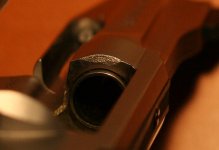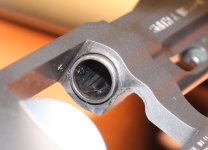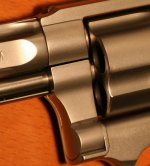feralcatkillr
Member
- Joined
- Apr 9, 2013
- Messages
- 23
- Reaction score
- 7
Hi, all. This is a continuation of my thread, http://smith-wessonforum.com/ammo/313901-buffalo-bore-failure-five-shots-seven-holes.html that I posted in the Ammo forum here. Please read it for all of the background, but here’s a summary:
I bought a Model 60 Pro Series brand new from local the gun shop two weeks ago. My first range session was last weekend and I have only fired a total of 130 factory rounds through the gun, as follows and in this order:
- 25 rounds .38 special Federal 158 gr LRN
- 25 rounds .38 special Remington 158 gr LSWC
- 25 rounds .357 magnum CCI Blazer 158 gr JSP
- 20 rounds .38 special +P Buffalo Bore 158 gr LSWCHP-GC
- 10 rounds .357 magnum American Eagle 158 gr JSP
- 25 more rounds .357 magnum CCI Blazer 158 gr JSP
Then (as you can read in the other thread) I posted some questions here about why the Buffalo Bore performed so oddly (terrible accuracy, separation of gas checks and burn-through of primers) and also e-mailed B.B. who said that it was probably because I fired lead bullets through it and leaded the barrel before I then fired their high-performance ammo, which lead to pressure problems that would explain the primer burn through.
So…… here’s what’s next. Today I’ve been alternating between some solventy patches and some copper brush scrubbing in the cylinder chambers and barrel, and have scrubbed it good and clean. But, because this is more “TLC” time than I had spend so far with this new gun, I just now noticed something. The front-left side of the frame, up by the barrel, is cut away a bit. I’ve attached three photos. When you look directly at the left side of the gun angled 90-degrees, you can see that the frame’s not perfectly straight there and has a bit of a crescent shape.
Next, if you look at the inside of the frame there to the left of the forcing cone, you can see the bit that is cut away and it has sort of a speckled, stipled look. The stipled look kind of looks like welding flux spatter, but much smaller and it’s a consistent texture. And remember, this isn’t something that is on top of or in addition to the frame, it’s cut away out of the frame. However, when you look at the rest of the frame around the forcing cone including the top strap and the right side, it all looks normal. (I attached a picture of that side too.)
So…. What the heck happened here? Did it come from the factory like this, or is it related to an over pressure ammo situation? Recall, I haven’t even really proven that over-pressure hypothesis, and I’ve only had 130 rounds, total, through the gun. Also, the barrel/cylinder gap on the gun is nice and tight for all five cylinders, and consistently angled (doesn’t tip or lean) The cylinder locks up beautifully (tighter than any revolver I’ve ever owned).
On the other hand…. This gun did come from the factory with quite a few other flaws. The barrel is clocked slightly to the left (when viewed from behind), the beveled portion at the top/front of the frame is a bit too far to the right, and the rear sight is machined into the top strap at a bit of an angle (too far to the right, at the front, then corrects itself and comes back more the left at the rear.
These latter issues are annoying but I had decided I was going to live with them because I bought this “kit gun” to be just that: something I always have with me clunking around in the pickup or in a fishing tackle box or in the backpack when camping. I was able to sight it in and compensate for the slightly off-kilter front sight by moving the rear sight to the left, so I wasn’t going to worry about cosmetic things. I was just happy to find a specimen with a great trigger pull, tight lock-up, and to my eye (I don’t have any feeler gauges) good barrel/cylinder gap.
Well now this frame “cut” has come to my attention and I’m not sure what to think. Did it come from the factory like this, or is it something that happened during the first, short range session. If it is some sort of flame cutting, why would it have occurred only way out there on the left side, and not up on the top strap which is much closer?
I bought a Model 60 Pro Series brand new from local the gun shop two weeks ago. My first range session was last weekend and I have only fired a total of 130 factory rounds through the gun, as follows and in this order:
- 25 rounds .38 special Federal 158 gr LRN
- 25 rounds .38 special Remington 158 gr LSWC
- 25 rounds .357 magnum CCI Blazer 158 gr JSP
- 20 rounds .38 special +P Buffalo Bore 158 gr LSWCHP-GC
- 10 rounds .357 magnum American Eagle 158 gr JSP
- 25 more rounds .357 magnum CCI Blazer 158 gr JSP
Then (as you can read in the other thread) I posted some questions here about why the Buffalo Bore performed so oddly (terrible accuracy, separation of gas checks and burn-through of primers) and also e-mailed B.B. who said that it was probably because I fired lead bullets through it and leaded the barrel before I then fired their high-performance ammo, which lead to pressure problems that would explain the primer burn through.
So…… here’s what’s next. Today I’ve been alternating between some solventy patches and some copper brush scrubbing in the cylinder chambers and barrel, and have scrubbed it good and clean. But, because this is more “TLC” time than I had spend so far with this new gun, I just now noticed something. The front-left side of the frame, up by the barrel, is cut away a bit. I’ve attached three photos. When you look directly at the left side of the gun angled 90-degrees, you can see that the frame’s not perfectly straight there and has a bit of a crescent shape.
Next, if you look at the inside of the frame there to the left of the forcing cone, you can see the bit that is cut away and it has sort of a speckled, stipled look. The stipled look kind of looks like welding flux spatter, but much smaller and it’s a consistent texture. And remember, this isn’t something that is on top of or in addition to the frame, it’s cut away out of the frame. However, when you look at the rest of the frame around the forcing cone including the top strap and the right side, it all looks normal. (I attached a picture of that side too.)
So…. What the heck happened here? Did it come from the factory like this, or is it related to an over pressure ammo situation? Recall, I haven’t even really proven that over-pressure hypothesis, and I’ve only had 130 rounds, total, through the gun. Also, the barrel/cylinder gap on the gun is nice and tight for all five cylinders, and consistently angled (doesn’t tip or lean) The cylinder locks up beautifully (tighter than any revolver I’ve ever owned).
On the other hand…. This gun did come from the factory with quite a few other flaws. The barrel is clocked slightly to the left (when viewed from behind), the beveled portion at the top/front of the frame is a bit too far to the right, and the rear sight is machined into the top strap at a bit of an angle (too far to the right, at the front, then corrects itself and comes back more the left at the rear.
These latter issues are annoying but I had decided I was going to live with them because I bought this “kit gun” to be just that: something I always have with me clunking around in the pickup or in a fishing tackle box or in the backpack when camping. I was able to sight it in and compensate for the slightly off-kilter front sight by moving the rear sight to the left, so I wasn’t going to worry about cosmetic things. I was just happy to find a specimen with a great trigger pull, tight lock-up, and to my eye (I don’t have any feeler gauges) good barrel/cylinder gap.
Well now this frame “cut” has come to my attention and I’m not sure what to think. Did it come from the factory like this, or is it something that happened during the first, short range session. If it is some sort of flame cutting, why would it have occurred only way out there on the left side, and not up on the top strap which is much closer?
Attachments
Last edited:





